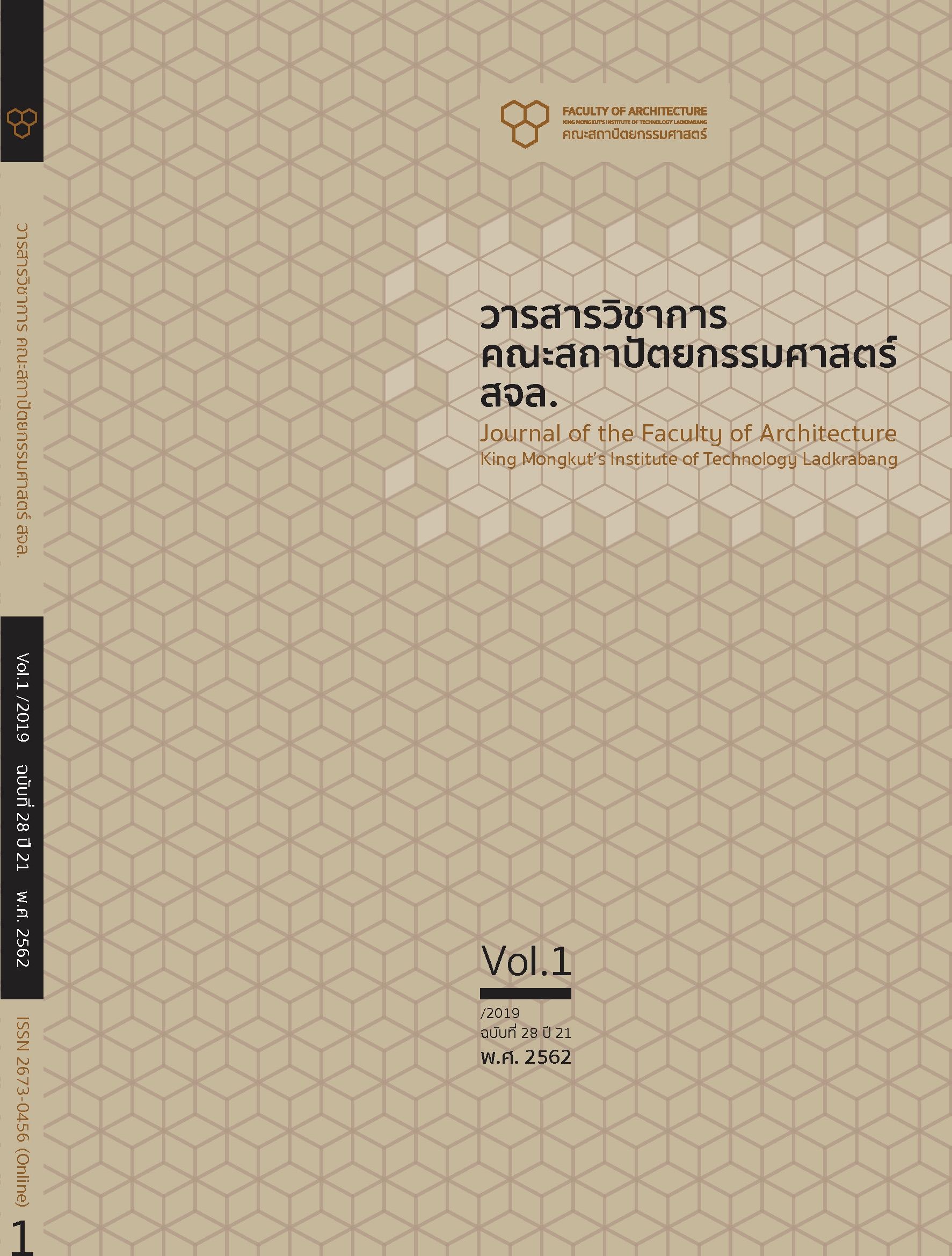Design Loom and Weaving Process of Traditional North-Eastern Textiles
Main Article Content
Abstract
บทคัดย่อ
การวิจัยครั้งนี้มีวัตถุประสงค์เพื่อศึกษา รวบรวมและวิเคราะห์กระบวนการผลิตผ้าทอพื้นเมือง สำหรับการออกแบบกี่ทอผ้ารูปแบบใหม่ภายใต้แนวคิด “กี่ใหม่ พฤติกรรมใหม่ ลายใหม่”ผลการวิจัยพบว่า กระบวนการผลิตผ้าทอพื้นเมืองอีสาน มีความคล้ายคลึงกันแต่มีความแตกต่างเกี่ยวกับขั้นตอนการผลิต และเทคนิคที่ใช้ในการผลิตกี่ที่นิยมใช้ทั่วไป คือ กี่กระทบ จากการสังเคราะห์ข้อมูล คุณสมบัติของกี่ทอผ้าแบบใหม่ ในด้านการทอผ้าสามารถทอผ้าได้คุณภาพดี เหมือนกี่แบบเดิมประกอบด้วยลักษณะทั้ง 3 ด้าน ได้แก่ 1) ด้านรูปแบบ: กี่ทอผ้าที่พัฒนาขึ้นนี้มีขนาดเล็กลงมากกว่ากี่ทอผ้าแบบเก่าโดย สามารถทา งานได้ในพื้นที่น้อยลงกระบวนการทอผ้าแบบเดิมใช้เวลานานในการทอผ้า แต่กี่ที่พัฒนาขึ้นนี้สามารถผลิตผืนผ้า ได้ 2 ผืนในเวลาเท่ากัน และสามารถสร้างลวดลายผ้าที่มีความแตกต่างกันทั้งสองผืนในเวลาเดียวกันโดยการใช้ตะกอ 2) ด้านพฤติกรรมการใช้งาน: กี่ทอผ้าที่พัฒนาขึ้นใหม่ใช้งานได้ง่ายกว่าแบบเดิม ผู้วิจัยเลือกใช้วิธีการยกตะกอด้วยมือ แทน วิธีเดิมที่ใช้เท้าเหยียบ วิธีนี้เหมาะสมกับทั้งผู้เริ่มต้นและผู้ที่มีความชำนาญในการทอผ้า 3) ด้านการสร้างลวดลาย: ผู้วิจัยได้ ออกแบบตะกอใหม่ ซึ่งแต่ละอันมีความแตกต่างกันสำหรับสร้างลวดลายผ้าทอที่แตกต่างกัน ผลการวิจัยในครั้งนี้ได้กี่ทอผ้าแบบใหม่ในแนวคิด “กี่ใหม่ พฤติกรรมใหม่ ลายใหม่” มีขนาดเล็กกว่าแบบเดิม ใช้งานได้ง่ายกว่า ประหยัดเวลามากขึ้น และสามารถผลิตชิ้นงานผ้าทอได้มากกว่า
คำสำคัญ: กี่ทอผ้าพื้นเมือง วิถีการทอผ้าภาคอีสาน เทคนิคการทอ
Abstract
The purposes of this research were to investigate, collect, and analysis a process in weaving of native fabric for a loom design under the concept of “A New Loom, A New Action and A New Pattern Style”. The result revealed that the process of all Thai North-eastern native fabric weaving process were similar, but there were differences in the method and the technique of production. The traditional loom that people prefer to use was “Kee-ka-tob”. The result showed that the efficiency of a new loom for weaving a fabric was similar to the traditional loom with three more advantages including, 1) physical feature: a new-developed loom was smaller than the traditional one, so a new one can be used within a limited area and produced two fabrics with different patterns with a similar amount of time as used in the traditional one, 2) user behavior: a new-developed loom was easier in use than the original loom. The researcher decided to apply a method lifting up the heddle by hand rather than using feet. This method gave benefit for both a beginner and an expert in weaving the fabric, and 3) creating new patterns: the researcher developed different new heddles to create new patterns of weaving fabric. The new loom under the concept of “A New Loom, A New Action and A New Pattern” was the final product of this research. It was smaller in size, easier in use, and save more times than the original one. Moreover, a new one could create more weaving fabric patterns than the original one.
Keywords: Traditional Loom, North-Eastern Weaving Style, Weaving Technique
Article Details
This work is licensed under a Creative Commons Attribution-NonCommercial-ShareAlike 4.0 International License.
Copyright Transfer Statement
The copyright of this article is transferred to Journal of The Faculty of Architecture King Mongkut's Institute of Technology Ladkrabang with effect if and when the article is accepted for publication. The copyright transfer covers the exclusive right to reproduce and distribute the article, including reprints, translations, photographic reproductions, electronic form (offline, online) or any other reproductions of similar nature.
The author warrants that this contribution is original and that he/she has full power to make this grant. The author signs for and accepts responsibility for releasing this material on behalf of any and all co-authors.
References
กัลยา วานิชย์บัญชา. (2553). การใช้ SPSS for windows ในการวิเคราะห์ข้อมูล. กรุงเทพฯ: ธรรมสาร.
ทรงพันธ์ วรรณมาศ. (2534). ผ้าไทยลายอีสาน. กรุงเทพฯ: โอ เอสพริ้นติ้งเฮ้าส์.
มณฑา จันทร์เกตุเลี้ยด. (2541). วิทยาศาสตร์สิ่งทอเบื้องต้น. กรุงเทพฯ: สมาคมเศรษฐศาสตร์แห่งประเทศไทยในพระบรมราชินูปถัมภ์
วิบูล ลี้สุวรรณ. (2541). มรดกทางวัฒนธรรมพื้นบ้าน. กรุงเทพฯ: ต้นอ้อ.
สำนักงานคณะกรรมการวัฒนธรรมแห่งชาติ. (2545). ผ้าไทย สายใยแห่งภูมิปัญญาสู่คุณค่าเศรษฐกิจไทย. กรุงเทพฯ: องค์การค้าของคุรุสภา.

